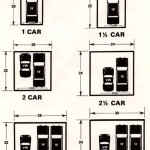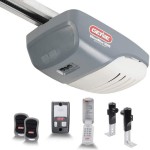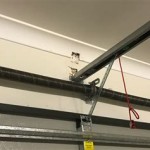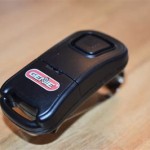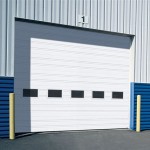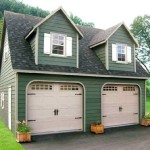Diagnosing and Resolving Wall Garage Door Opener Issues
A garage door opener, particularly the wall-mounted control panel, is an essential component of a modern home. It offers convenience and security, allowing homeowners to easily access their garages without manually lifting the door. However, like any electromechanical device, garage door opener wall controls can experience malfunctions. When a wall-mounted garage door opener stops working, it can be frustrating and disruptive. This article provides a comprehensive guide to diagnosing and resolving common issues affecting wall-mounted garage door openers, ensuring the smooth operation of your garage door system.
Before diving into specific problems, it's crucial to understand the general operation of a garage door opener system and the wall control's role within it. The system typically consists of the main opener unit (containing the motor and drive mechanism), the garage door itself, tracks, springs, safety sensors, and the wall-mounted control panel. The wall control, usually installed near the entrance to the house or garage, communicates with the main opener unit, sending signals to open, close, or stop the door. This communication can occur via wired connections or, in some newer models, wirelessly.
A malfunctioning wall control can manifest in a variety of ways. It might become unresponsive, fail to activate the door, or exhibit intermittent operation. Proper diagnosis involves systematically checking potential causes, ranging from simple issues like power supply to more complex problems with wiring or internal components. The following sections will detail common causes and troubleshooting steps to identify and fix the problem.
Power Supply and Electrical Issues
The most fundamental aspect of any electrical device is its power supply. If the wall control is not receiving power, it will be unresponsive. This can stem from multiple sources, including a tripped circuit breaker, a faulty outlet, or a problem with the wiring connecting the control panel to the main opener unit.
Checking the Circuit Breaker: The first step is to verify that the circuit breaker controlling the garage door opener is not tripped. Locate the breaker in your home's electrical panel and ensure it is in the "on" position. If it is tripped (in the middle or "off" position), reset it by switching it to the "off" position and then back to the "on" position. If the breaker trips again immediately or shortly after being reset, it indicates a potential electrical short or overload in the garage door opener system or wiring. Consult a qualified electrician to investigate and repair the underlying issue before continuing.
Testing the Outlet: If the circuit breaker is fine, the next step is to check the outlet that the garage door opener is plugged into. Use a voltage tester or multimeter to confirm that the outlet is providing the correct voltage (typically 120V in North America). If the outlet is not working, try plugging another device into it to confirm the issue is with the outlet itself and not just the garage door opener. If the outlet isn't working, investigate the wiring to the outlet or engage a qualified electrician to diagnose and repair the electrical circuit.
Examining the Wiring: Assuming the power source is functioning correctly, the wiring connecting the wall control to the main opener unit must be examined. This wiring is typically low-voltage wiring, often 22-gauge or similar. The wire runs from the opener to the wall control, usually along the ceiling and walls of the garage. Inspect the wiring for any signs of damage, such as cuts, frays, or loose connections. Pay close attention to the points where the wires connect to the wall control and the main opener unit. Ensure the wires are securely attached and free from corrosion. If any damage is found, repair or replace the affected section of wiring, using appropriate connectors and wire strippers. Ensure the power is disconnected before working on any wiring.
Battery Issues (Certain Models): Some newer wall controls incorporate battery backup features. If the battery is depleted or malfunctioning, it can prevent the wall control from operating even if the main power supply is functional. Check the battery compartment and replace the battery if necessary, ensuring the correct type and polarity. Refer to the garage door opener's manual for specific instructions on battery replacement.
Wiring and Connection Problems
Beyond the main power supply, the integrity of the wiring and connections between the wall control, safety sensors, and the main opener unit is critical for proper operation. Even if the system has power, faulty wiring or loose connections can disrupt the signal transmission, preventing the wall control from activating the door.
Checking the Wall Control Connections: The wall control is typically connected to the main opener unit by two or more wires. These wires are usually connected to terminals on the back of the wall control and the main opener unit. Inspect these connections carefully. Ensure the wires are securely attached to the terminals and that there is no corrosion or damage to the terminals themselves. Tighten any loose screws or replace corroded terminals. It is useful to use a small brush and electrical contact cleaner to clean the terminals thoroughly.
Examining the Safety Sensor Wiring: The safety sensors, located near the bottom of the garage door tracks, are designed to prevent the door from closing if an obstruction is detected. These sensors are crucial for safety and also affect the operation of the wall control. If the sensors are misaligned or the wiring is faulty, the wall control may not function. Check the wiring to the safety sensors for any signs of damage or loose connections. Ensure the sensors are properly aligned so they are facing each other, and that there are no obstructions blocking the sensor beams. A common cause of sensor malfunction is sunlight directly hitting the sensors.
Testing the Wiring Continuity: If visual inspection of the wiring does not reveal any obvious problems, it is necessary to test the continuity of the wires using a multimeter. Disconnect the wires from both the wall control and the main opener unit. Set the multimeter to the continuity testing mode (usually indicated by a diode symbol or a sound). Touch one probe of the multimeter to one end of the wire and the other probe to the other end. If the multimeter indicates continuity (typically with a beep or a low resistance reading), the wire is intact. If there is no continuity, the wire is broken or damaged and needs to be replaced. Repeat this process for all wires connecting the wall control and the main opener unit.
Short Circuits: A short circuit in the wiring can also cause the wall control to malfunction. A short circuit occurs when two wires accidentally come into contact, creating a direct path for electricity to flow. This can damage the wall control or the main opener unit. Look for any areas where the wires may be pinched, frayed, or damaged in such a way that the conductors are exposed. If a short circuit is suspected, carefully isolate the affected wires and repair or replace them.
Wall Control Malfunction and Programming Issues
If the power supply and wiring are functioning correctly, the problem may lie within the wall control itself. The wall control can fail due to internal component failure, damage, or programming issues, especially in newer models that use more complex features.
Physical Damage: Inspect the wall control for any signs of physical damage, such as cracks, broken buttons, or evidence of water damage. If the wall control is visibly damaged, it will likely need to be replaced. Disconnect the power supply before attempting to remove or inspect a damaged wall control.
Button Functionality: Test each button on the wall control to ensure it is functioning correctly. Sometimes, buttons can become stuck or unresponsive due to dirt, debris, or wear and tear. Clean the buttons and the surrounding area with a clean, dry cloth. If a button is still unresponsive, it may need to be repaired or replaced.
Programming Issues: Some wall controls require programming to communicate with the main opener unit. This is especially common in models that use rolling codes or other security features. Refer to the garage door opener's manual for instructions on how to program the wall control. The programming process typically involves pressing a "learn" button on the main opener unit and then pressing a button on the wall control. Follow the instructions carefully to ensure the wall control is properly programmed.
Replacing the Wall Control: If all other troubleshooting steps have been exhausted and the wall control is still not working, it may be necessary to replace it. When replacing the wall control, ensure that you purchase a compatible model that is designed to work with your specific garage door opener. Refer to the garage door opener's manual or contact the manufacturer for guidance on selecting the correct replacement wall control. Installation typically involves disconnecting the old wall control, connecting the wires to the new wall control, and mounting the new wall control in the same location. Ensure the power is disconnected before replacing the wall control.
Interference Issues: In rare cases, interference from other electronic devices can disrupt the signal between the wall control and the main opener unit. This is more likely to occur in models that use wireless communication. Try moving any nearby electronic devices that may be causing interference, such as cordless phones, Wi-Fi routers, or other wireless devices. If the problem persists, try switching the garage door opener to a different frequency channel, if supported.

Garage Door Opener Doesn T Work Wall Control Troubleshooting
How To Manually Open Or Close A Garage Door

Fixed Chamberlain Garage Door Opener Control Panel Not Working Youtube
Garage Door Wall Button Not Working But Remote Works Guide

Can T Open Door With Chamberlain Wall Mount Garage Opener Rjo70 Tailwind Support

Replacing The Wall Control On A Garage Door Opener
:max_bytes(150000):strip_icc()/troubleshooting-common-garage-door-problems-1398186-01-b4bded1aaf55436f8b00ccaa1fa7fff8.jpg?strip=all)
Garage Door Won T Open Or Close Reasons And Solutions
Garage Door Wall Button Not Working But Remote Works Guide

Chamberlain Motion Sensing Garage Door Opener Wall Control 041a7327 1 The Home

Genie Garage Door Opener Not Working Check These First

